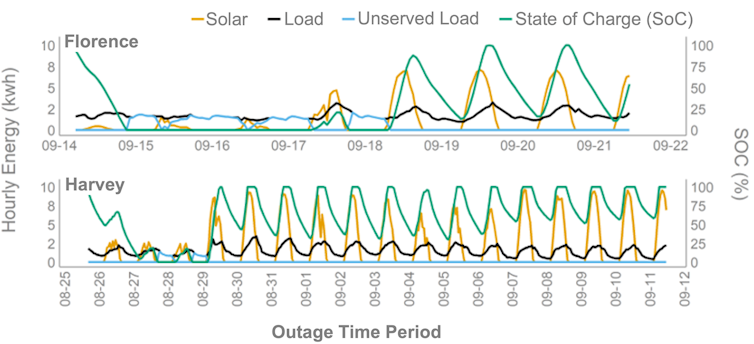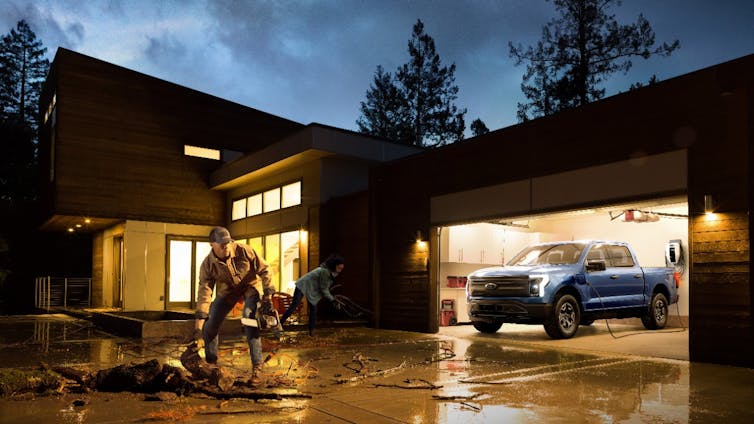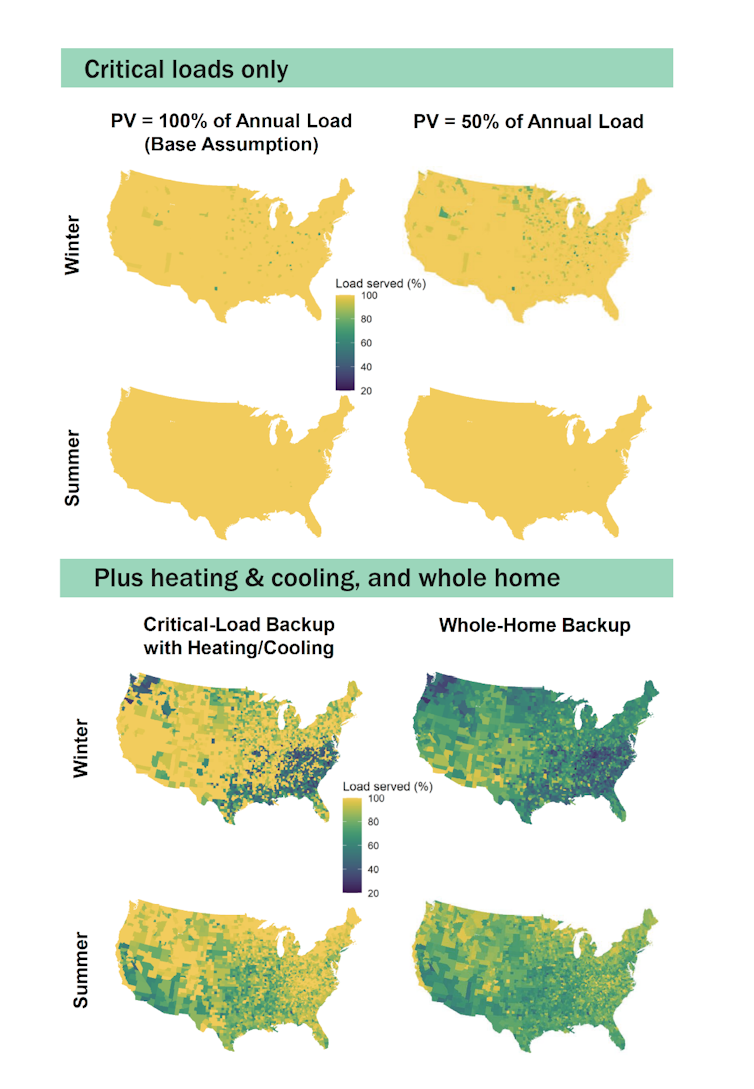Hurricane Ian’s destructive winds and flooding are likely to cause long-lasting power disruptions across large areas of Florida. The hurricane is the latest in a line of severe temperature and cold conditions that have shut off power to millions of Americans in recent years for several days.
In many disaster- and outage-prone regions, people are beginning to ask whether the investment in solar panels on rooftops as well as battery-storage systems could keep the lights on and the air conditioner running in the event that the power grid fails.
When the grid goes down the majority of solar systems that are without batteries will stop functioning. With batteries, homes are able to be disconnected from the grid. Each day, the sun lights the home and charges up the batteries that provide power through the night.
Our group at Berkeley Lab examined what it would be like for homes and commercial structures to withstand long power outages, of three days or more, with solar and batteries.
How much solar and storage cost?
For an new report, we modeled an unavoidable power outage in all counties in the U.S., testing whether rooftop solar systems with a 10- or 30-kilowatt-hour battery could power critical loads, like lighting, refrigeration Internet service, and pumps. We also tested should it be able to extend the power as well as power cooling and heating or even supply power to an entire home.
For a better understanding To put it in perspective, the most sought-after battery available is the Tesla Powerwall, is just 13 kWh of capacity.
We found that even a modest system of solar and one battery can provide power to critical homes for days at a stretch, practically anyplace in the United States.
However, our maps show that supplying backup for cooling and heat can be a challenge, though not a daunting one. The homes located in the Southeast and Pacific Northwest often have power-hogging electric resistance heaters that exceed the capabilities of solar as well as storage in winter time outages. homes with efficient heat pumps performed better. The load of summer air conditioning can be heavy in the Southwest which makes it difficult to provide all the cooling requirements through storage and solar power in an event of a summer blackout.
A larger array of batteries and solar systems can assist, but the ability to meet demand for outages will depend on the weather, the energy efficiency of the house is, and other aspects. For example, thermostat adjustments during power outages can reduce the need for cooling and heating as well as permit solar systems with storage to provide backup power for longer periods.
Solar and storage using the power of a 10-kWh battery provide power backup in many scenarios. Berkeley Lab, CC BY
The power source for commercial buildings is different, according to the type of building. Retail stores and schools that have enough roof space for solar in relation to building power demand, fare much better than large, energy-intensive buildings like hospitals.
What would solar have done in the event of 10 disasters in the past?
We also looked at 10 real-world events that caused outages from 2017 to 2020, including hurricanes, wildfires and storms, and modeled building performance in specific areas and actual weather patterns during and after the outages.
We found that in seven outages the majority of homes were capable of sustaining essential loads, as well as heating and cooling by using solar power with 30 kWh of storage, or about two Powerwalls.
But the weather that surrounds the outage can have a big impact, especially for storms. Following Hurricane Florence destroyed power across North Carolina in 2018, clouds hung around over three whole days dimming or even cutting off solar panels’ power.
The hurricane Harvey The other hand, struck on the Texas coastline in the month of August of 2017 but moved on to cause widespread destruction elsewhere in Texas. The skies over Corpus Christi cleared even as it took a week or more to restore power. Storage and solar power could have been a huge assistance in this case as they could provide all the electrical needs of a typical single-family home, after it cleared.
What a typical house would have done with solar as well as 30 kWh storage following hurricanes Florence and Harvey. The blue light line indicates the short periods of ‘unserved load’, or shortages in power supply following the storms. The charge state shows batteries were able to stretch solar power through the night.
FIND SOLAR SYSTEMS/BACKUP FOR YOUR HOME
We also found that solar energy can be effective in less cloudy events such as wildfire prevention shutoffs in California and after the 2020 derecho storm in Iowa.
The source of heat in a home is also a key factor. In a period of five to 10 days following an ice storm in Oklahoma in the year 2020 We discovered that solar power and a 30-kWh battery could have supplied almost all the power and warmth required by homes that have the natural gas heating system or heat pump. However, homes that have electric resistance heating would have come short.
In Texas more than half of homes are heated with electricity mostly resistance heaters. Energy Star-rated heat pumps – that provide heating as well as cooling – consume half as much energy for heat production as electrical resistance heaters. They are also more efficient in cooling than the typical new air cooling unit. The conversion of older resistance heaters into new heat pumps is not only able to only save money and reduce the demand for electricity, but also improve resilience during outages.
New backup options
Setting up storage and solar to provide backup power in a home or building takes more effort and costs more – just one Powerwall will cost from US$12,000 to $ 16,500 for a complete system installation, including tax incentives or other. This is about the cost of a fair-sized solar system. Nevertheless, a growing number people are installing these.
Over 90% of solar projects that were built located in Hawaii in 2021 were paired with batteries following an amendment to the regulation. Now these solar power stations are helping to power the grid as coal plants are being retired.
California has more than 1.5 million rooftop solar systems. Many customers are retrofitting batteries on the systems or adding new solar plus storage due to the fact that utilities have been forced to use “public safety power shutoffs” to reduce the chance of wildfires sparked by power lines on dry, windy days.
Electric cars and trucks have much more battery storage than a Powerwall and are a great source of battery storage for future home batteries too. Ford
As well, new types that use backup energy are being developed from electric cars, particularly. Ford has partnered with SunRun to integrate its brand new F150 Lightning electric pickup truck with solar and a two-way charger that can utilize the battery of the truck to power homes. The basic version of the truck comes with an 98-kWh battery. This is the equivalent of more than 7 Tesla Powerwall stationary batteries.
Critical power to support critical services
A fire station located in Puerto Rico offers a glimpse of what solar and storage can do. Following the devastating hurricane Maria cut power for a period of time in 2017, more than 40000 solar panels were set up on the island, most of them paired with battery storage. One of those is situated in the town of Guanica, in Guanica, the town. Guanica, which had been not able to handle emergency calls in previous outages.
When Hurricane Fiona’s wind and floods again cut off power to most of Puerto Rico in September 2022 The fire station was still in operation.
“The solar system is working beautifully!” Sgt. Luis Saez told Canary Media the day after Fiona knocked out power. “We did not lose power all throughout the hurricane.”


E



Comments are closed.